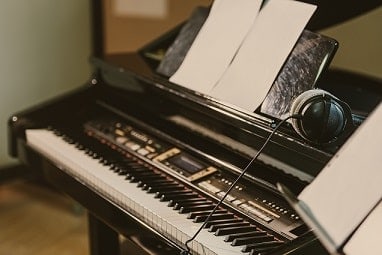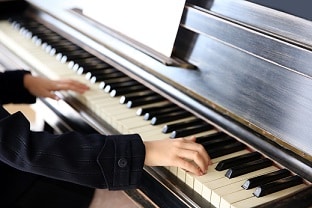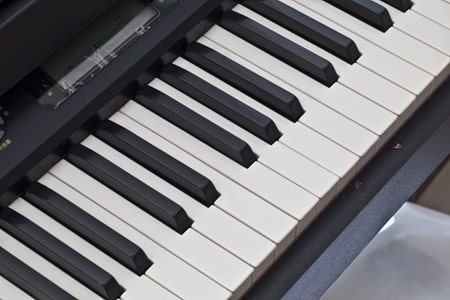As an Amazon Associate I earn from qualifying purchases.
Growing up as a young piano student I always wondered why my teachers suggested I get an acoustic piano instead of a traditional keyboard. They would always say that hammer action was going to be important for me in the long run. She would always say that weighted keys would not give me the kind of performance I needed, and therefore advocated for me to invest in a grand piano.
The difference between hammer action and weighted keys is the amount of resistance. Keyboards with hammer action replicate the same playing characteristics of acoustic pianos. Like an acoustic piano, the bass keys are heavier while the treble keys have a lighter touch. Weighted keys are completely balanced with the same heaviness from top to bottom of the keyboard.
As someone who is new to digital keyboards, those two descriptions can seem confusing. An acoustic piano, however, has tapered weight from the top to the bottom, and that’s important as a developing pianist; read about the differences between acoustic and digital pianos here. Next, I’ll share with you why it’s important that you start a student with graded hammer action so that they can get the most authentic experience.
Want to Learn Piano?Click Here

Understanding Fully-Weighted Vs Semi-Weighted
To understand how the action on digital keyboards work we need to understand some basic keyboard terminology first. There are several types of weighted actions to consider; semi-weighted and fully-weighted. Semi-weighted and fully-weighted keys might sound the same, but they really aren’t.
When dealing with Semi-weighted keys the noticeable difference is in the resistance of the keys. Semi-weighted uses a spring mechanism in combination with weights that are attached to each key. When a pianist depresses the key it will feel nearly effortless.

Although the keys depress quickly, they do feel sluggish as they rise back up. For that reason trying to execute some pianistic techniques like a glissando or quick repetition is not always easy to do.
Compared to an acoustic piano, the action is not nearly the same sort of resistance and weight across the board. Read here to see how acoustic pianos work.
Fully-Weighted action is similar to semi-weighted, but with more resistance to improve the feel as you play. These keyboards typically provide equal weight across all of the keys. Weights are added underneath the keys to add more resistance, and it has stronger return springs as well. The goal here is for the pianist to still develop playing endurance.
Lastly, there are Fully-weighted keyboards with hammer action (The Yamaha DGX-660 is a great example of this). These keyboards are trying to create the most realistic touch possible. To achieve this they are built with hammer mechanisms installed along with the weights. These are some of the best digital keyboards with hammer action.
This drastically improves the touch and resistance of each key so that they feel different. For example, some keyboards will have more resistance in the bass notes and less resistance in the treble notes; just like a real acoustic piano would have. We consider this to be “scaled hammer action”.
Why Hammer Action Is Better

If you’re not going to invest in an acoustic piano and plan to get a digital keyboard, then it’s important that you invest in one with hammer action.
In terms of overall development, hammer action is going to really aid your muscle development as a pianist.
Hammer action is essential to developing a real feel for acoustic piano playing whenever you encounter one.
Piano study is almost like a sport. The kind of equipment we use has a direct impact on our developmental success. Keyboards with hammer action allow us to work develop a unique sound, play accurate dynamics and execute articulations like staccatos, accents, and legato.
If the keyboard were semi-weighted or fully-weighted without hammer mechanisms, those performance aspects would not be easily achievable.
A digital piano with hammer action does a great job of taking what we do with our hands and arms and producing an accurate representation of that.
With today’s technology, these keyboards can quickly calculate the amount of force you play with, provide realistic key depth and also provide the right kind of rebound and resistance to make it feel like the real thing.
If a pianist were to train on a piano that utilized equal weight across the keys or a slow release then it would not prepare them to use acoustic instruments in the future. That’s just not how acoustic pianos work.
Anytime a student goes to a piano lesson or wants to give a stage performance, an acoustic piano will feel almost foreign to them physically. The speed at which they play would feel like a struggle because the muscle development just isn’t there. On top of that creating dynamics will also be a hurdle for them.
Concerns With Hammer Action Pianos
As much as I love hammer action keyboards, I must admit that they aren’t perfect. The goal of it is to recreate an acoustic piano feel, but it’ll never quite feel exactly like one.
As someone who’s owned all types of keyboards, I can definitely say that hammer action is the clear favorite. Here are a few concerns I have with these digital pianos.
Getting Too Used To Synthetic Keyboard Action
My biggest concern is students getting too used to the synthetic action vs the real thing. For example, some families have acoustic pianos and digital pianos in their home.
The preference for that family would likely be to send their student into the other room where they can play with headphones for noise convenience.
The problem with that scenario is that if the student doesn’t get enough exposure to an acoustic piano that they could end up developing a poor playing technique.
If you plan to purchase a piano with this kind of action then there needs to be an effort to balance that practice out.
Even those who own pianos with hammer action already need to consider finding ways to get their student more exposure to real acoustic pianos; preferably a grand if possible.
Size And Weight
When investing in a piano with hammer action you almost certainly will be dealing with a complete console system. Rather than a flimsy keyboard on a music stand, these consoles take up quite a bit of room. They are pretty much the size of a standard upright piano at around 5 feet in width and 4 feet off of the ground.
Some of the larger consoles weight up to 150 lbs in weight; so you may need help moving it around the home. I consider these consoles like the Yamaha Clavinova especially to basically be a piece of musical furniture.
Overall it’s still not the size of a grand piano and traditional upright, but you’ll want to carve out space in the home for it.
Price
The other big disadvantage of these pianos is the price. Surely you won’t be spending tens of thousands of dollars as you would with a Steinway, but do expect to drop a hefty amount.
Some of the lower end digital pianos cost around $600, but those pianos don’t usually have “hammer action”. The more realistic the piano feels, the more it’s going to cost. Somewhere in the $2000 – $3500 range is more accurate.
This might seem terrible, but considering an upright piano average between $5000-$6000, the price is a mere fraction of that for a digital piano. Other things that contribute to some consoles being so expensive is the hardware and software built into those systems. Many of them have state of the art surround sound speaker systems.
Along with that are sound filters so that pianists can replicate performing in recital halls, outdoors and more. Some of the Yamaha Clavinova pianos also have lesson built-in and plenty of accompaniment features to keep a young student busy at the instrument for hours. That all might seem like a lot, and in some cases, it is, however for the price it’s quite the bargain.
What’s The Best Hammer Action Keyboard Available?
The answer to this question comes down to a couple of factors. I’ve tested many pianos over the years and there’s no doubt in my mind that Yamaha produces the best line of keyboards on the market today. There’s just no brand out there that has it as refined as they do, making Yamaha the goto option for group piano classes, churches, and schools.
Yamaha has worked to refine their graded hammer action keyboards over the years, and the Clavinova series is where you’ll want to look first. The Yamaha Clavinova has been around since 1983 and is widely regarded to be the best portable piano available.
It’s gone through many iterations over the years, but the consistency in tone, touch and design have continually improved each time. Another model that is well respected is the Yamaha Arius which takes on many of the same characteristics of the Clavinova. It’s generally cheaper, but still provides quality stereo sound, graded hammer action, and the traditional console design.
Yamaha digital pianos are generally on the pricey side, but hammer action instruments aren’t something you want to cheap out on if you want the right kind of development. This keyboard is an excellent option for the beginner as well as the serious pianist.
I’ve practiced on these instruments many times and it’s always felt like I’m playing the real thing. For kids just getting their feet wet and wanting a reliable instrument that replicates an acoustic piano, the Clavinova is the best option there.
Other Weighted Hammer Action Pianos To Choose From
If the Yamaha Clavinova is out of your price range, there’s no need to panic! There are a few other options out there worth the investment, and I feel pianists can still develop well on these. The key with any of these pianos is to balance this with practice on real acoustic instruments too.
1. Korg LP-380
For the first option, I highly recommend the Korg LP-380. It’s a console system, but not as space consuming as the Yamaha Clavinova. The thing with this unit is simplicity in its operation. It has a set of controls along the top panel so pianists can easily choose between sounds, volume and more.
The keys on the Korg are well made, thick and provide a smooth feel that’s very close to a quality acoustic piano. Korg is known for producing really high-quality piano sounds, and their speaker systems give an accurate amount of resonance and responds well to hand releases quite well.
An often overlooked feature with some keyboards is the pedal. This Korg features a damper pedal that you can actually half pedal just like an acoustic piano can. Overall it’s got a clean design and it’s relatively inexpensive compared to the others out there!
2. Yamaha YDP163B
I really like what Yamaha has to offer across all of their keyboards, but the YDP163B is a nice option here. It’s a smaller console, but the feel is just like a grand piano. The tone of this model is designed to replicate their 9′ concert grands, so you can imagine just how wonderful that must sound.
It uses graded hammer action that closely resembles that of a grand piano. Pianists can expect to have stronger resistance in the low end and then a much lighter touch in the top. The keytops are made with synthetic ivory which helps a lot with gripping and the realistic feel. Much like the Korg model, the pedal is responsive to the amount of pressure you apply while playing.
Outside of how it plays, the size, and price, this piano has some nice features on it. It comes preprogrammed with 50 play-along songs along with the ability to pair with an IOS device. For practicing habits there’s the ability to record two tracks at once, so students and teachers can use this to work on specific technical problems and measure success over time.
3. Casio PX-160
I can still remember my first Casio keyboard. They’ve really come a long way over the last few years, and one of their most popular models is the PX-160 which I describe in detail here. This is probably the most compact of all the keyboard consoles, and it’s priced well.
There’s not a lot of bells and whistles on this model, but it has everything a pianist needs. The pedals depress smoothly, and the keys have a nice grip. It features graded hammer action for a realistic feel, although not as refined as the Korg or Yamaha. This model also comes with a furnished bench although an adjustable one would be the wise choice to make here.
The cool thing with PX-160 is that the keyboard can actually detach from the stand. If you ever wanted to move it around or take it with you on a trip then that’s a major selling point here. Headphones are also included, so this is a great piano that’s ready right out of the box!
Hello & thanks for stopping by! I’m a professional concert pianist and piano instructor. In the United States, I’ve given successful performances in several places including New York, Florida, Connecticut, & New Jersey, I have also performed internationally in Italy and made my Carnegie Hall debut in 2014. I enjoy blogging about the piano, the art of performance, general music, current events and the latest in music production.

Why Are Digital Pianos So Expensive - Joshua Ross
Friday 25th of January 2019
[…] a really cheap digital piano won’t even have weighted keys let alone hammer action. The difference between hammer action and weighted action is important because that helps develop your playing […]
How To Buy A Piano - The Complete Guide - Joshua Ross
Wednesday 12th of September 2018
[…] The lowest possible entry point for a piano is a digital keyboard. Ranging from $100 all the way to $3000, there’s plenty of options to choose from. These keyboards come in all shapes, sizes, the number of keys and more. It’s important that you understand whether your keyboard is semi-weighted vs fully-weighted. […]